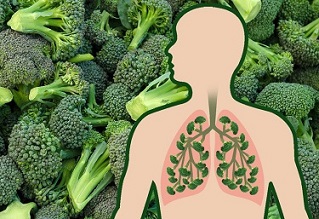Harnessing the Power of Cruciferous Vegetables For Lung Health Especially In The COVID-19 Era!
Thailand Medical News Team Aug 19, 2023 1 year, 8 months, 19 hours, 47 minutes ago
Lung Health: In a groundbreaking study, researchers at the renowned Francis Crick Institute have unveiled a remarkable discovery that sheds light on the crucial role played by molecules found in common vegetables, such as broccoli and cauliflower, in maintaining a healthy barrier within the lungs. This revolutionary insight has the potential to revolutionize our understanding of lung infections and holds promise for enhanced preventative measures and treatments.

The focus of this groundbreaking research lies in the aryl hydrocarbon receptor (AHR), a protein strategically located at barrier sites like the gastrointestinal tract and, as revealed by this study, within the delicate structures of the lung.
Cruciferous vegetables, including kale, cauliflower, broccoli, and cabbage, contain natural molecules that act as dietary "ligands" for AHR. When consumed, these vegetables activate the AHR, initiating a cascade of protective genetic responses. These responses are key to maintaining the integrity of the lung's barrier system, ensuring it remains robust against the assault of pollutants, viruses, and bacteria.
The Complexity of Lung Barrier Function
To comprehend the significance of this discovery, it is essential to delve into the intricate architecture of the lung barrier. Comprising just two layers - one of endothelial cells and another of epithelial cells - the lung barrier facilitates the vital exchange of oxygen while simultaneously warding off potential threats. This dual role presents a delicate balance that is essential for overall respiratory health.
Intriguing Experiments Unravel the Protective Potential of AHR
To unravel the protective potential of AHR in maintaining the lung barrier's integrity, researchers conducted a series of meticulously designed experiments involving mice. These experiments yielded remarkable insights into the effects of AHR activation during infections. When mice were exposed to the flu virus, the study team observed a concerning leakage of blood into the lung airspaces due to the compromised barrier. However, when AHR was overactivated, this leakage was significantly reduced, underscoring the critical role of AHR in preserving the barrier's function.
Equally noteworthy were the findings regarding weight loss and resilience to infections. Mice with enhanced AHR activity demonstrated reduced weight loss during flu infection and displayed heightened resistance to bacterial infections following the initial viral assault. These observations further emphasize the protective effects of AHR activation within the lung.
AHR: A Game Changer in Dietary Influence on Lung Health
A particularly intriguing revelation from this research is the direct link established between dietary intake and AHR activity during infections. The study illustrated that flu-infected mice experienced a reduction in protective lung AHR activity, but only when they had not been consuming AHR ligands in their diet prior to the illness. This dynamic underscore the importance of a balanced and nutritious diet, even during periods of illness, to support the body's defense mechanisms. The diminished intake of AHR ligands during il
lness led to reduced AHR system activity and subsequently more significant lung damage.
Relevance to COVID-19 and Future Directions
The researchers also speculate about the implications of their findings for other respiratory viruses, including the infamous COVID-19. Prior research has suggested a decrease in lung AHR activity during COVID-19 infection, making it plausible that similar protective mechanisms could be at play. This raises intriguing possibilities for investigating the effects of various respiratory viruses on AHR and exploring alternative pathways through which dietary molecules may impact lung function.
Unlocking the Gut-Lung Axis: A Holistic Perspective
Beyond its immediate impact on lung health, this study unravels an intricate network that extends from the gut to the lungs, revealing what can be termed a "gut-lung axis." This axis illuminates the interconnectedness of dietary choices and their profound influence on the body's ability to fend off infections and maintain barrier integrity. Research from other institutions has corroborated this connection by showcasing how dietary factors activate AHR in gut endothelial cells, thus contributing to protective mechanisms against gut infections. This compelling insight emphasizes the far-reaching impact of dietary choices on various barrier organs and underlines the importance of holistic approaches to health.
A Future of Enhanced Lung Health
The implications of this groundbreaking research are vast and encompass both immediate and future applications. By shedding light on the critical role of AHR in maintaining lung barrier integrity and elucidating the link between dietary consumption and lung health, this study presents a promising avenue for the development of targeted interventions. From enhancing current preventive strategies for lung infections to exploring innovative dietary approaches that leverage AHR activation, the potential to revolutionize lung health is both tantalizing and transformative.
In conclusion, the findings unveiled by the Francis Crick Institute researchers serve as a beacon of hope in the realm of respiratory health. The intricate dance of molecules found in vegetables, the orchestration of AHR activity, and the delicate balance of the lung barrier weave together a complex narrative that highlights the profound interplay between diet, immunity, and infection.
The study findings were published in the peer reviewed journal: Nature
https://www.nature.com/articles/s41586-023-06508-4
https://www.nature.com/articles/s41586-023-06287-y
For the latest about
Lung Health, keep on logging to Thailand Medical News.
